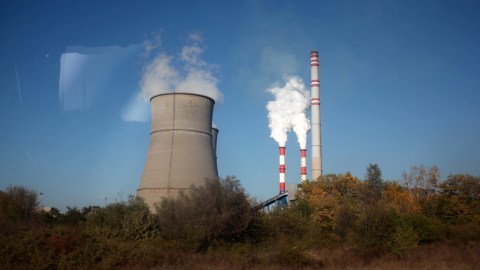Giant fans that suck CO2 out of the air are operational in Italy

- The fans may be carbon neutral, but the goal should be ‘carbon negative.’
- Nevertheless: every way of tackling climate change helps.
- More carbon-eliminating/recycling products could be hitting the market soon.

One of the ClimeWorks fans in question.
ClimeWorks
With the U.N. releasing a report on climate change that demands sustained attention, it’s worth noting that ClimeWorks — a company based in Switzerland — opened its third ‘carbon capture’ site on October 2nd in Troia, Italy.
The ClimeWorks carbon capture center in Italy only takes the equivalent of 32 cars off the road per year. That’s more than zero, but it’s nowhere near where the numbers should be. At best, as David Roberts pointed out over at Vox this past July, some of the capture sites in the world are — at best — carbon neutral, and the goal should be to produce something that is ‘carbon negative,’ i.e., something that takes more carbon out of the air, not just something that puts nothing into the air.
Of the three carbon capture sites ClimeWorks has in the world, the one in Iceland is the only capture site that’s carbon negative.
That doesn’t mean that there aren’t promising steps being taken with the carbon neutral sites: as Akshat Rathi notes in Quartz, where the story was first reported, the carbon dioxide first captured at ClimeWorks’s first carbon capture site was “fed to a greenhouse, which boosted the growth of the plants inside it.” The gas captured and converted at the plant in Italy will be used to provide fuel for trucks. These two examples illustrate one of many different ways in which Climeworks could theoretically pursue the big picture with creativity.

Map of currently active Carbon Capture sites across the world.
There are other considerations worth bringing into the framing of this as well, many of which can be found in a lengthy paper from the University of Sheffield.
- New carbon capture products on the verge of hitting the market (focusing on chemical looping, membrane-based technology, ionic liquids, and others.) Just because a site is carbon neutral now doesn’t mean that there aren’t carbon negative products on the way.
- The cost of ‘de-carbonising’ key industrial sectors will ultimately get ‘lost in the noise of the market.’ In other words: there isn’t an economic disincentive for companies to de-carbonize. The claim that it might cost money to shift away from carbon doesn’t ultimately hold true.
- Climate change requires a multi-pronged response: if the equivalent of 32 cars are taken off the road every year, then that’s 32 fewer cars for the world to worry about.





